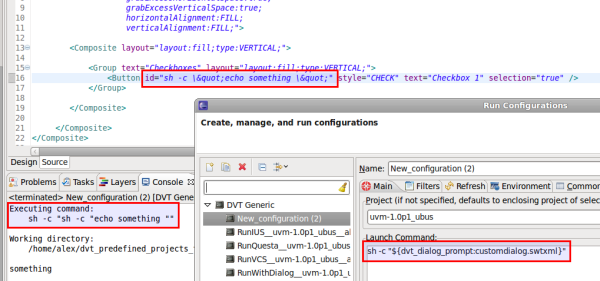Customizing the Dialog Output
Because the id of a widget can be any string, you can construct a wide variety of output formats simply by changing the form of the id. Some common use-cases are:
- Bash style dash arguments, e.g.:
id=” -name “ => -name value
- Simulator style plus arguments, e.g.:
id=” +incdir+” => +incdir+value
- Make style equals arguments, e.g.:
id=” name=” => name=value
The dvt:Container widget
This widget acts just like a Composite (i.e. you can surround sets of widgets or composites with it), but also takes some configuration parameters that are applied for all the widgets it contains.
To specify values for checkboxes use checkboxOffValue and checkboxOnValue parameters:

XML
<dvt:Container layout="layout:grid;" parameters="checkboxOnValue: -cov 1;checkboxOffValue: -cov 0">
<Button id=" " style="CHECK" text="Collect coverage" selection="true" />
</dvt:Container>
<dvt:Container layout="layout:grid;" parameters="checkboxOnValue: -wave 1;checkboxOffValue: -wave 0">
<Button id=" " style="CHECK" text="Dump wave" />
</dvt:Container>
- Output:
-cov 1 -wave 0
The default separator for list elements is ;. To change it, use listSeparator parameter:
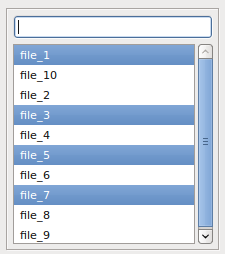
XML
<dvt:Container parameters="listSeparator: -f ">
<dvt:DirectoryFilesListing id=" -f " rootDirectory="/tmp/files"/>
</dvt:Container>
- Output:
-f file_1 -f file_3 -f file_5 -f file_7
To prevent the widget id from being output when the value is empty use noIdForEmptyValues parameter:
XML
<dvt:Container parameters="noIdForEmptyValues:true">
<Text id=" -text "></Text>
</dvt:Container>
To quote values use quoteWith parameter:

XML
<dvt:Container layout="layout:grid;numColumns:2;" parameters="quoteWith:'">
<Label text="Text:"></Label>
<Text id=" -text " style="BORDER" text="text with whitespace that needs to be quoted" />
</dvt:Container>
- Output:
-text ‘text with whitespace that needs to be quoted’
Note
If you wish to quote a string with double quotes you should escape the double quote character from XML syntax as follows:
<dvt:Container parameters=”quoteWith:"”>
To show information about the value of a certain widget in the console title use showInTitle parameter:
XML
<dvt:Container parameters="showInTitle:true">
<Label text="Seed:"></Label>
<Text id=" -seed " style="BORDER" text="42223" />
</dvt:Container>

Output

To disable a set of widgets based on the selection state of a radio button, checkbox or the value of a combobox or text widget, wrap the set of widgets you want to disable in a <dvt:Container> and specify which widget dictates its enablement using the enabler attribute. You can refer to a widget with its standard XML XPath within the dialog xml:
XML
<Group text="Radio buttons" layout="layout:fill;type:VERTICAL;">
<Button id=" -test random" style="RADIO" text="Run a random test" selection="true" />
<Button style="RADIO" text="Run a specific test" />
</Group>
<dvt:Container enabler="/Composite/Composite[1]/Group[1]/Button[2]" layout="layout:fill;type:HORIZONTAL;">
<sv:ClassSelector id=" -test " question="Pick test" baseClassName="uvm_test" />
</dvt:Container>
Output
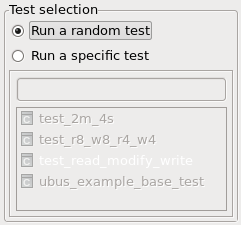
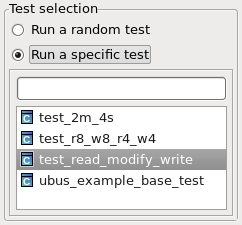
XML
<Combo items="run_random_test;run_specific_test" layoutData="horizontalAlignment:CENTER;">
</Combo>
<dvt:Container enabler="/Composite/Composite[1]/Combo == run_specific_test" layout="layout:fill;type:HORIZONTAL;">
<sv:ClassSelector id=" -test " question="Pick test" baseClassName="uvm_test" />
</dvt:Container>
Output
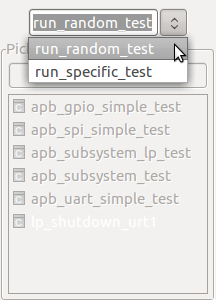
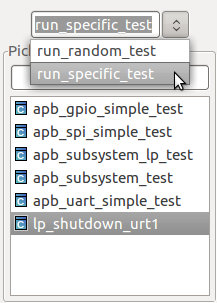
You can combine the states of multiple buttons or comboboxes/text widgets using logical operators, and you can refer the same widget from multiple <dvt:Container> widgets:
XML
<Group text="Resolution" layout="layout:row;type:VERTICAL;">
<Button style="RADIO" text="800x600" selection="true" />
<Button style="RADIO" text="1024x768" />
<Button style="RADIO" text="1280x1024" />
<Button style="RADIO" text="1600x1200" />
</Group>
<Group text="Refresh Rate (Hz)" layout="layout:row;type:VERTICAL;">
<Button style="RADIO" text="70" />
<dvt:Container
enabler="/Composite/Composite[1]/Group[1]/Button[1] ||
/Composite/Composite[1]/Group[1]/Button[2] ||
/Composite/Composite[1]/Group[1]/Button[3]">
<Button style="RADIO" text="80" />
</dvt:Container>
<dvt:Container
enabler="!/Composite/Composite[1]/Group[1]/Button[3] &&
!/Composite/Composite[1]/Group[1]/Button[4]">
<Button style="RADIO" text="90" />
</dvt:Container>
<dvt:Container enabler="/Composite/Composite[1]/Group[1]/Button[1]">
<Button style="RADIO" text="100" />
</dvt:Container>
</Group>
<Group text="Color depth (bpp)" layout="layout:row;type:VERTICAL;">
<dvt:Container
enabler="/Composite/Composite[1]/Group[1]/Button[1] ||
/Composite/Composite[1]/Group[1]/Button[2]">
<Button style="RADIO" text="16" />
</dvt:Container>
<dvt:Container
enabler="/Composite/Composite[1]/Group[1]/Button[3] ||
/Composite/Composite[1]/Group[1]/Button[4]">
<Button style="RADIO" text="32" />
</dvt:Container>
</Group>
Output




Note
To easily obtain the XPath to a specific widget run the dialog once, and identify the widget(s) inside the <dialog_name>.snapshots.xml file which is automatically generated/updated by DVT after each run.
Further customization can easily be achieved by using a simple script for processing arguments. E.g. with the following bash snippet you can convert any argument to any desired form:
#!/bin/bash
#
# bash_arg_converter.sh
#
while [ $# -gt 0 ]; do
case $1 in
-custom_*)
argname="$1"
shift
argval="$1"
## Customize here to desired format ##
echo -n " $argname $argval "
;;
*)
echo -n " $1 "
;;
esac
shift
done
In the configuration command box use the following instead of ${dvt_dialog_prompt}:
./bash_arg_converter.sh ${dvt_dialog_prompt:customdialog.swtxml}
How to avoid quoting problems
In the .swtxml file it is recommended to use \" for nested quotes and for the Launch Command (Run Configurations > Launch Command) the variable ${dvt_dialog_prompt:customdialog.swtxml} should be surrounded by quotes, like in the image below:
